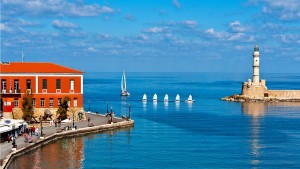 Chania Greek: Χανιά, is the second largest city of Crete and the capital of the Chania regional unit. It lies along the north coast of the island, about 70 km (43 mi) west of Rethymno and 145 km (90 mi) west of Heraklion.
Chania Greek: Χανιά, is the second largest city of Crete and the capital of the Chania regional unit. It lies along the north coast of the island, about 70 km (43 mi) west of Rethymno and 145 km (90 mi) west of Heraklion.
The official population of the municipal unit (the former municipality) is 53,910, while the municipality has 108,642 (2011) inhabitants. This consists of the city of Chania and several other towns and villages, including Kounoupidiana (pop. 8,620),Mournies (pop. 7,614), Souda (pop. 6,418), Nerokouros (pop. 5,531), Daratsos (pop. 4,732), Perivolia (pop. 3,986), Galatas (pop. 3,166) and Aroni (pop. 3,003).
History: Chania is the site of the Minoan settlement the Greeks called Kydonia, Greek for quince. It appears on Linear B as ku-do-ni-ja. Some notable archaeological evidence for the existence of this Minoan city below some parts of today’s Chania was found by excavations in the district of Kasteli in the Old Town. This area appears to have been inhabited since the Neolithic era. The city reemerged after the end of the Minoan period as an important city-state in Classical Greece, one whose domain extended from Chania Bay to the feet of the White Mountains. The first major wave of settlers from mainland Greece was by the Dorian Greeks who came around 1100 BC. Kydonia was constantly at war with other Cretan city-states such as Aptera,Phalasarna and Polyrrinia and was important enough for the Kydonians to be mentioned inHomer‘s Odyssey (xix.200).In 69 BC, the Roman consul Caecilius Metellus defeated the Cretans and conquered Kydonia to which he granted the privileges of an independent city-state. Kydonia reserved the right to mint its own coins until the third century AD.
The old town:
Despite being heavily bombed during World War II, Chania’s Old Town is considered the most beautiful urban district on Crete, especially the crumbling Venetian harbour. The borders of the Old Town are the mostly destroyed old Venetian wall (and bulwarks) and this has been the cradle of all the civilizations which were developed in the area. The central part of the old town is named Kasteli and has been inhabited since Neolithic times. It is located on a small hill right next to the seafront and has always been the ideal place for a settlement due to its secure position, its location next to the harbour and its proximity to the fertile valley in the south. Nowadays it is a bit more quiet than the neighbouring areas of the west part of the district. The Splantzia quarter (next to the east part of Kasteli) is also largely untouched and very atmospheric. A plan for its future development is now under consideration.
The main square of the Old Town (next to the west end of Kasteli) is Eleftherios Venizelos Square, also known as Syntrivani (from Turkishşadırvan ‘fountain’). It is the heart of the touristic activities in the area. Next to this (on the west side) lies the Topanas district, which was the Christian quarter during the Ottoman period. Its name comes from the Venetian ammunition warehouse (Turkish tophane), which was located there. The Jewish quarter (Evraiki or Ovraiki) was located at the north-west of the Old Town, behind the harbour and within the borders of Topanas. The whole Topanas area is generally picturesque, with many narrow alleys and old charming buildings, some of which have been restored as hotels, restaurants, shops and bars. This makes it a lively and colourful place especially during the warm period (April–October). In the winter, it still remains a centre of activities (especially for nightlife) but in a more quiet and atmospheric way.
Finally, a very distinctive area of the Old Town is the harbour itself and generally the seafront (“akti”). Akti Tompazi, Akti Kountouriotou and Akti Enoseos (marina) all feature several historical buildings and a thriving nightlife. The main street that combines the modern town with the old town is Halidon Str.
Education and Research:
- The Technical University of Crete. It is the largest educational institution in Chania with around 2600 undergraduate and 700 postgraduate students. It is focusing on Electronic and Computer Engineering, Environmental Engineering, Production Engineering and Management, Mineral Resources Engineering, Sciences and Architecture. Future plans include a Civil Engineering and a Fine Arts department.
- The Chania branch of the Technological Educational Institute of Crete.
- The Mediterranean Agronomic Institute of Chania
- The Merchant Marine Academy of Crete (AEN KRITIS)
Other research and intellectual institutes and societies in Chania are:
- The National Research Foundation “Eleftherios K. Venizelos”
- The Mediterranean Architecture Centre (KAM)
- The Institute of Olive Tree and Subtropical Plants of Chania
- The Institute of Cretan Law
- The Historical, Laographical and Archaeological Society of Crete
- Institute of Regional Press, Chania
Primary and secondary schools are mainly public in Chania (as in all cities in Greece). However, there has been a slow development of some private high schools recently. Among the “Eniaia Lykeia” (Unified Upper Secondary Schools) of the town there is an autonomous Ecclesiastical Lyceum in Agios Mattheos.
